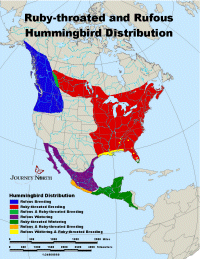Today's Report Includes:
- The
Migration: Highlights
and Maps
- Animations:
Snapshots
of the 2008 Season
- A
Special Thanks! To
Our Hummer Helpers
- Year-end
Evaluation: Please
Share Your Thoughts!
Please
Report
Your Sightings! >>
Your Sightings! >>
 Distribution Map |
||
| Rufous
|
Ruby-throated
|
|
Highlights:
Keep Watching and Wondering
"We were up in our first hot-air balloon ride," reports Maddy in Fairlee, Vermont. "About 500 feet up in the air, two hummingbirds were flying right next to the balloon! It was an awesome experience!" Wow. Researchers say that rubythroats usually fly just above the treetops. After all, that's a great way to keep an eye out for darting insects and waiting nectar! Observers continue to be thrilled and amazed when they come across these remarkable migrants. Fifth grader Keith Hawley from West Sacramento, California says, "The (rufous hummingbird) is so beautiful that it is now my favorite bird."
Then for the next four or five months, look for signs that the hummingbirds now among us are preparing for another incredible journey. This slideshow will remind you what to watch for >>. |
| Rufous
Hummingbird Migration: 2008 |
Ruby-throated
Hummingbird Migration: 2008 |
- In which
week were the greatest numbers of hummers reported? In which week did
the leading edge seem to make the biggest leap northward?
- Choose one species. Describe how the migration moved forward week-by-week after the hummingbirds entered the United States. (You can draw arrows on a blank map to show this.)
We are also grateful to all the photographers who generously allowed Journey North to post images of hummingbirds and their amazing antics!
And finally, thanks to all of YOU for keeping your eyes open, feeders full, and reports prompt. We couldn't track these species without your help! We look forward to seeing you again in February, 2009.
Only with your help can we document Journey North's reach, impact, and value. The information you provide is critical for planning new initiatives and for improving Journey North. Thank you!
Year-end Evaluation >>
- JN for Kids Photo Studies: Stunning hummingbird photos and video clips along with observation questions >>
- Reading: Hummingbird Booklets and Slideshows >>
- Reading: Researching Hummers — One at a Time >>
- Map Reading: Making Sense of Journey North Maps (Core Questions) >>
- Photo Study: Who else is searching for food on these blooms? >>
- Tip:
Learn
how to keep the best feeder food for your visiting hummingbirds!
>>
- FINAL Hummingbird Arrivals: Rubythroat Chart and Rufous Chart
- Assessment Tools: What Have We Learned About Hummingbirds? >>
- Slides/Tips: How to Help Hummingbirds and Their Habitats >>
More
Hummingbird Lessons and
Teaching Ideas!
This is the FINAL Hummingbird Migration Update. Join us again in February, 2009!









